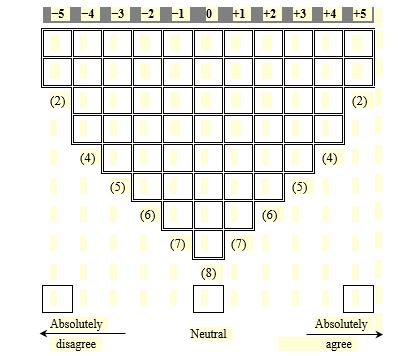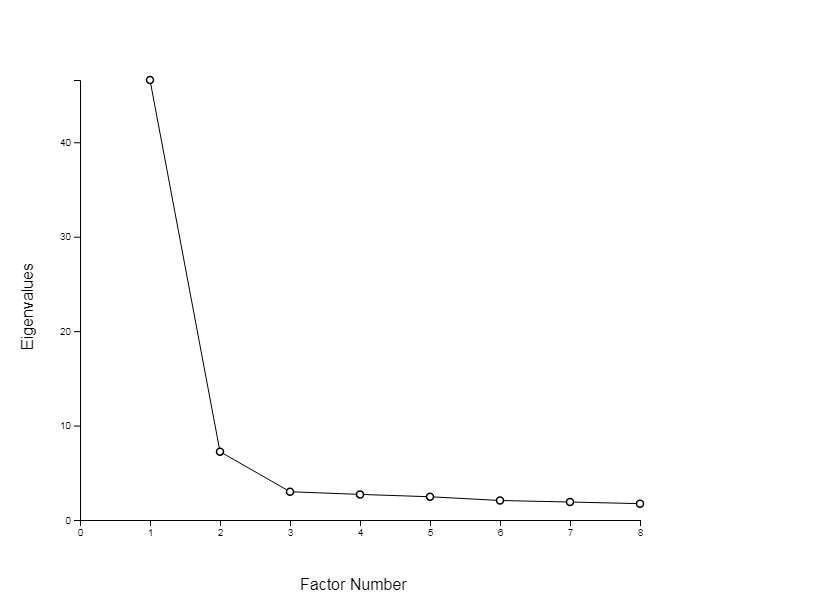Abstract
This article discusses factors influencing the formation of creative activity of students in the learning process. The study involved 94 teachers and students of the Hanoi national University of Education and the Peoples’ Friendship University of Russia from September 20th, 2018, to January 20th, 2019. Q-methodology was used to determine the factors that affect the creative activity of students by using a web application - Ken-Q Analysis version 1.0.4. The Q-sample consists of 56 statements generated by various methods, such as structured interviews and thorough interviews; questionnaire with open-ended questions; collection of statements based on previous research. Results of the study revealed two main factors that strongly influence the formation of students' creative activity in the learning process: the first factor is students themselves; the second factor is teachers’ activity. These factors account for 58% of the study dispersion. Sixty-four participants contributed to the definition of the factor 1. Thirty participants contributed to the definition of the factor 2. Teachers and students belonged to the factor 1 showed a high level of agreement or disagreement with the following statements: “a student has a positive attitude, interest to the creative activity” (+5); “wish to study, students’ curiosity” (+5). Teachers and students belonged to the factor 2 showed a high level of agreement or disagreement with the following statements: “teaching activity of teachers motivates students for creativity” (+5); “teacher is ready to support creative process of students at the lesson” (+5); “teacher does not use group forms of teaching” (-5).
Keywords: Q-methodologycreative activitylearning
Introduction
The formation and the development of students’ creative activity are always the main task in research of educated scientists.
The formation of creative activity of the individual, capable of responding to the challenges of modernity and the demands of the society social mandate, is one of the most important tasks of the modern school, due to the fact that creativity is considered as an integral characteristic of an individual development. Along with the level of training, creative activity, as one of the indicators of students' personal growth, affects the quality of their education. (Verb, 1976, p.39)
In recent decades there have been changes in the modern society requirements for successful employees of the 21st century. Therefore, this question has been increasingly interesting for research than ever.
There have been a lot of studies on creativity throughout the world: Psychological factors affecting the creative potential of students in the classroom (Sadeghi & Ofoghi, 2011); Factors affecting teachers’ creative studying in private Islamic schools in Kuala Lumpur (Hamed, Preece, & Hashim, 2016); Assessment of factors affecting student creativity in fashion and textile design (Powell & Carrol, 2013); Factors affecting the creativity of undergraduate students at Nakhon Ratchasima Rajabhat (Boonchan, Pupat, & Seesan, 2015); The standard definition of creativity (Runco & Jaeger, 2012); Formation of the creativity of students in the context of the education informatization (Ramankulov et al., 2016); Creative learning environment in education - a systematic review of the literature (Davies et al., 2013); Creativity and intelligence (Shrivastava, 2016). These studies were focused on revealing the factors affecting the creativity of students; the connection between creativity and intelligence; teachers’ creative activity; the formation of students' creativity. However, the above-mentioned studies only explore the factors that influence the creativity of students in the direction of teachers or students.
There has not been a study combining the views of teachers and students on the factors shaping the creative activity of students in the learning process. Moreover, the researchers did not focus on the complete use of the study participants’ subjective view. This study uses the Q-methodology to overcome the above-mentioned limitations of previous studies. This research is considered as the first in the field of education that uses the Q-methodology in the study on the formation of students' creative activity in the learning process.
Problem Statement
Creativity is the necessary ability of successful employees in the 21st century. Creativity is formed and developed in the process of learning at the university. Nevertheless, the educational results still do not meet the requirements of the development of modern society. The learning process is a complex process that includes the teaching activities and learning activities of students, as well as the common goal of developing a comprehensive personality for students. Therefore, to study the factors influencing the formation of creative activity of students, it is necessary to study the opinions of both teachers and students on this issue, it is necessary to clarify the factors influencing the formation of students’ creative activity from both sides: teachers and students.
Research Questions
The given research is directed on clarifying the following questions: (1) what factors formulate students’ creative activity in learning process? (2) what influences much on students’ creative activity on the part of students themselves? (3) what influences much on students’ creative activity on the part of teachers?
Purpose of the Study
The goal of the research is to reveal factors influencing on the formation of the students’ creative activity in learning process.
Research Methods
94 teachers and students from the Hanoi national University of Education (Vietnam) and the Peoples' Friendship University of Russia (Russia) were involved in the study. The Q-methodology (Brown, 1993; Watts, Stenner, 2005) was used to determine the factors that influence the creative activity of students using a web application - Ken-Q Analysis version 1.0.4 (Banasick, 2018). The Q-sample t consists of 56 statements generated by various methods, such as structured interviews and thorough interviews; questionnaire with open-ended questions; collection of statements based on previous research. The Q-grid (fig.

Findings
The scree plot test allows to construct graph from proper values (Cattell, 1966). Herewith, proper values are arranged on the vertical axis and factors are on the horizontal axis. The factors are remained when the slope of the line starts striving for the level of the horizontal axis. Thus, the point of this start is called “factor scree”, and factors to the left are accumulated and to the right are moved away (Webler, Danielson, & Tuler, 2009). The scree plot demonstrates that the flex point was in the place of the third factor (fig.

The results of the study have revealed two main factors that strongly influence the formation of students' creative activity in the learning process: Factor 1 - the students themselves; Factor 2 - teaching activities of teachers. These two factors account for 58% of the research dispersion. Sixty-four participants contributed to the definition of the factor 1. Thirty participants contributed to the definition of the factor 2.
Teachers and students of the factor 1 showed a high level of agreement or disagreement with the following statements: “a student has a positive attitude, an interest in creative activity” (+5); “wish to learn, student curiosity” (+5); “students have an intrinsic motivation for creativity” (+4); “students are sure of their creative abilities” (+4); “students need to develop creative competence in the learning process” (+4); “students have creative thinking and creative habit” (+4).
Teachers and students of the factor 2 showed a high level of agreement or disagreement with the following statements: “teaching activity of teachers motivates students for creativity” (+5); “teacher is ready to support the creative process of students at the lesson” (+5); “teacher does not use group forms in learning process” (-5).
Conclusion
The study has determined two factors which influence much on the formation of students’ creative activity in learning process: Factor 1 – students themselves; Factor 2 – teaching activity on the part of teachers. According to this, teachers and students are able to clearly navigate in teaching and learning activities to achieve creative goals.
References
- Banasick, S. (2018). Ken-Q Analysis – A web application for Q methodology version 1.0.4. Retrieved from: https://shawnbanasick.github.io/ken-q-analysis
- Boonchan, B., Pupat, P., & Seesan, B. (2015). Variables Affecting the Creativity of Undergraduate Students at Nakhon Ratchasima Rajabhat University. Creative Education, 6, 2241–2249.
- Brown, S. R. (1993). A Primer on Q Methodology. Operant Subjectivity, 16(3/4), 91–138.
- Cattell, R. B. (1966). The Scree Plot Test for the Number of Factors. Multivariate Behavioral Research, 1, 140–161.
- Davies, D., Jindal-Snape, D., Collier, C., Digbya, R., Haya, P., & Howe, A. (2013). Creative learning environments in education - A systematic literature review. Thinking Skills and Creativity, 8, 80–91.
- Hamed, P. K., Preece, A. S. D., & Hashim, C. N. (2016). Factors influencing creative teaching among teachers in Islamic private schools in Kuala Lumpur. Retrieved from: http://www.iium.edu.my/capeu2016/wp-content/uploads/2017/02/031.pdf
- Powell, N. B., & Carrol, K. (2013), Assessment of factors affecting student creativity in Fashion and Textile Design. Retrieved from: https://www.researchgate.net/publication/257936754
- Ramankulov, S., Usembayeva, I., Berdi, D., Omarov, B., Baimukhanbetov, B., & Shektibayev, N. (2016). Formation of the Creativity of Students in the Context of the Education Informatization. International Journal of Environmental and Science Education, 11(16), 9598–9613.
- Runco, M. A., & Jaeger, G. J. (2012). The Standard Definition of Creativity. Creativity Research Journal, 24(1), 92–96.
- Sadeghi, A., & Ofoghi, N. (2011). The psychological factors affecting students' creativity inside the class (CIC) (case study the University of Guilan, Iran). Procedia Social and Behavioral Sciences, 15, 263–270.
- Shrivastava, S. (2016). Creativity and intelligence. International Journal of Recent Advances in Multidisciplinary Research, 3(3), 339–1344.
- Verb, M. A. (1976). The formation of aesthetic orientations of senior school students: Study book. Leningrad: LGPU Publ.
- Watts, S., & Stenner, P. (2005). Doing Q methodology: theory, method and interpretation. Qualitative Research in Psychology, 2, 67–91.
- Webler, T., Danielson, S., & Tuler, S. (2009). Using Q method to reveal social perspectives in environmental research. Greenfield MA: Social and Environmental Research Institute.
Copyright information

This work is licensed under a Creative Commons Attribution-NonCommercial-NoDerivatives 4.0 International License.
About this article
Publication Date
28 December 2019
Article Doi
eBook ISBN
978-1-80296-075-4
Publisher
Future Academy
Volume
76
Print ISBN (optional)
-
Edition Number
1st Edition
Pages
1-3763
Subjects
Sociolinguistics, linguistics, semantics, discourse analysis, science, technology, society
Cite this article as:
Thuy*, B. T. L., Kazarenkov, V., Tran, V. D., Dorofeeva, V., & Tinh, N. T. (2019). Use Of Q-Methodology For Studying Students Creative Activity. In D. Karim-Sultanovich Bataev, S. Aidievich Gapurov, A. Dogievich Osmaev, V. Khumaidovich Akaev, L. Musaevna Idigova, M. Rukmanovich Ovhadov, A. Ruslanovich Salgiriev, & M. Muslamovna Betilmerzaeva (Eds.), Social and Cultural Transformations in the Context of Modern Globalism, vol 76. European Proceedings of Social and Behavioural Sciences (pp. 3492-3496). Future Academy. https://doi.org/10.15405/epsbs.2019.12.04.469
